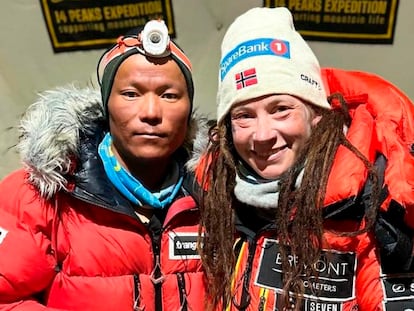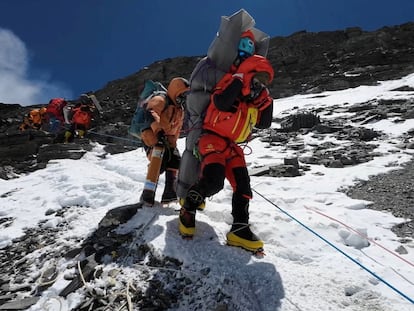Hassan or viral death on K2: Searching for an opportunity to improve your life
The high-altitude porter was the victim of both the indifference of those around him and the increasingly cruel business of mountain tourism in the Himalayas and Karakoram

The trivialization of online death has also affected the world of mountaineering. The viral tragedy of high-altitude porter Muhammad Hassan is not, however, a first. There have been similar cases before on Everest and other eight-thousanders, but nobody recorded them and posted them on the firewood pyre of the social networks. However, it is worth remembering the case of David Sharp, whose misfortune occurred in similar circumstances: on Everest, dozens of people stepped over him, looking the other way, on their way to the roof of the world. Having contemplated the evidence — i.e., the repeated gesture of passing over the body of a human being in agony — all that remains is to understand how it is possible to achieve such detachment. And yet, the inexplicable may remain inexplicable in view of the circumstances that led to such disheartening images being shared on the internet.
Hassan, a Pakistani, was a high-altitude porter because of necessity. Very few people in Pakistan dream of becoming mountaineers: they dream of escaping poverty. And the money from mountain tourists is a great shortcut if you are willing to work and assume the risk of losing your life doing so. The alternatives for Hassan were familiar to millions in his situation: working the land, cutting and carrying firewood, picking and drying apricots and looking after a humble herd of goats. He was 27 years old, and had a wife and three children. And, according to several witnesses, his experience in the high mountains was limited, a circumstance that may explain certain things.
In the art of making foreign currencies profitable, the Nepalese have quickly taken the upper hand over the Pakistanis, who are almost intruders in their own mountains. Everest’s summit fever has become too small for Sherpa mountaineers, who have been opening new markets for the past five years. K2, the second-highest mountain on the planet and the most respected, where Hassan lost everything, is the new onerous playground of Nepal’s guide companies.
On July 27, 100 people climbed to the summit of K2. A barbarity, taking into account the meager historical statistics of the mountain and the bad weather that day. In the past, only mountaineers would set foot on the summit of K2, sometimes accompanied by local porters or Sherpas. Now, tourists are legion, a fact that also helps to explain Hassan’s fate that same day.
For decades, one reality prevailed in the discourse of the Himalayas: above 8,000 meters, in the death zone, no one can help anyone. You had to be self-sufficient and accept your destiny. The passage of time has significantly altered this axiom and, also, the conduct of those who never accepted it. What was seen as an immutable reality has become a half-fallacy: it is possible to help someone in distress above 8,000 meters. You only need three things: the will to do it, human resources and, occasionally, money. Hassan suffered an accident in one of the worst possible places: on the traverse under the gigantic block of ice that dominates the Bottleneck on K2.
At first, no one could agree on the cause: an avalanche? the impact of a block of ice? his depleted artificial oxygen? a fall? All, at almost the same time? In any case, something left Hassan prostrate. He was in that area to help with the placement of fixed ropes, sent by the agency that had hired him. “Apparently,” explains Luis Miguel Soriano, mountaineer and high-altitude cameraman, “what really happened is that he suffered a bad fall and was left hanging upside down from the fixed rope. The trail was very narrow under the big serac and if you stepped off it you slipped dangerously. The weight of the oxygen cylinders presumably caused him to hang upside down when he fell and he was unable to get back up. He was like that for a while until a Sherpa I talked to explained to me that he helped him get back to the trail. The next day, when I passed by the same spot at night on my way to the summit, I did not notice that a bulge tucked in to the flank was a person: I only discovered him in daylight, during the descent, and by then he had been dead for hours.”
According to the testimonies gathered, there was enough bottled oxygen and qualified personnel in the long queue of summit hopefuls and workers to improvise a delicate rescue. But, it seems, there were other issues at stake: fixing the rope that would allow the clients to progress, satisfying their demands, returning to base camp as soon as possible. In other words, with a couple of exceptions who tried to revive Hassan, the remainder didn’t feel they had to get involved in helping him, or they did not consider the effort worthwhile given the location of the accident and the slim chances of Hassan’s survival. But it is worth remembering that several climbers have been rescued from practically the summit of Everest, taken to a lower altitude camp, and extracted by helicopter. In Pakistan, however, there is no air rescue service and army helicopters only fly in very special situations. How, then, can a person be rescued from a position such as Hassan’s? With the promise of good money, capable of mobilizing half a dozen Sherpas well-stocked with artificial oxygen, judiciously employing fixed ropes and improvising descents in the snow. Slow, costly, dangerous... but possible. No one, it seems, was able or willing to offer money from base camp in exchange for a rescue attempt. No one saw any reason to do so of their own accord.
One of the most repeated descriptions of Hassan by his colleagues at base camp made it clear that he lacked experience not as a mountaineer, but as a high-altitude porter: he was wearing clothes that were outdated and he was carrying unsuitable material for the task. “Yes, I can corroborate that,” Soriano says: “He was very poorly equipped and was not wearing a down suit, as we all do, and when he fell, in addition to injuring himself with his crampons, he damaged his back and the upper part of his clothes were torn, almost exposing his torso, which at that altitude above 8,000 meters was more than serious. He immediately began to convulse and I don’t know how long it would have taken for him to die.” Would it have been a different story if a wealthy client had suffered the accident? This is how mountain tourism works: some people pay to climb a mountain, and by doing so they believe they acquire a right over such uncontrollable phenomena as illness, accidents, or weather. They pressurize the agencies and the workers and insist that they have the right to launch a summit attempt. Just a decade ago, no one in their right mind would have tackled the summit of K2 under the latent danger of avalanches.

“Hassan had very little chance of survival”
On July 27, several climbers claim to have turned back after being caught in avalanches. The fixed ropes saved them: some gave up, while others continued. They had paid for a summit and nothing was going to separate them from their destiny, not even if they had to lengthen their stride to avoid a black and yellow lump. In the past, those who risked it all to reach the summit of a mountain were said to be possessed by “summit fever.” But they were expert mountaineers. Now, that same summit fever — to claim a peak that has been conquered a thousand times and is barely a prize worth framing in the living room at home — seems to legitimize the selfishness of a few.
“Hassan had very little chance of survival after his accident, and a rescue in that situation was complex, which does not rule out, in my view, that something should have been attempted. Afterwards, seeing the images of people walking over his body while he was still alive was very shocking and while I don’t want to excuse them, it is true that they were just putting one foot in front of the other. They were very physically challenged and walking like automatons. These people were neither physically nor technically prepared to attempt a rescue and the Sherpas who were with them have to take care of their clients and ensure that nothing happens to them, and that leaves very little margin to help others... which does not mean that they should not have tried to save Hassan because his life was more important than any summit,” says Soriano.
But the evident lack of self-sufficiency in the high-altitude environment, or of a genuine mountain culture among tourists, does not fully explain what happened either. Expert mountaineers have left behind companions under the half-truth that it was not high enough to get involved in a rescue. Others, like the Romanian Horia Colibasanu, preferred to expose himself to death rather than abandon Iñaki Ochoa de Olza. If Kristin Harila had suffered an accident on July 27, to cite the most high-profile mountaineer of the moment, would there have been a rescue? Would she have warranted more attention than Hassan? “Hassan was part of the Seven Summits Club group, with which I was traveling,” explains Soriano. “Interestingly, Alex Abramov, the expedition leader, gave the order two days before the accident to all the Pakistani high-altitude porters to return to base camp, because the team’s Sherpas were complaining that they were getting sick, their work was not productive, and they were consuming resources such as bottled oxygen or cooking gas. All the Pakistanis descended except Hassan: for him it was very important because he had very little experience and, in his case, reaching the summit would have allowed him to climb several rungs in the social and work hierarchy of the country. When he died, he was not working.”
Ultimately, Hassan’s fate was conditioned by his humble origins, a simple man looking for an opportunity to change his life thanks to the increasingly cruel business of mountain tourism in the Himalayas and Karakoram.
Sign up for our weekly newsletter to get more English-language news coverage from EL PAÍS USA Edition
Tu suscripción se está usando en otro dispositivo
¿Quieres añadir otro usuario a tu suscripción?
Si continúas leyendo en este dispositivo, no se podrá leer en el otro.
FlechaTu suscripción se está usando en otro dispositivo y solo puedes acceder a EL PAÍS desde un dispositivo a la vez.
Si quieres compartir tu cuenta, cambia tu suscripción a la modalidad Premium, así podrás añadir otro usuario. Cada uno accederá con su propia cuenta de email, lo que os permitirá personalizar vuestra experiencia en EL PAÍS.
¿Tienes una suscripción de empresa? Accede aquí para contratar más cuentas.
En el caso de no saber quién está usando tu cuenta, te recomendamos cambiar tu contraseña aquí.
Si decides continuar compartiendo tu cuenta, este mensaje se mostrará en tu dispositivo y en el de la otra persona que está usando tu cuenta de forma indefinida, afectando a tu experiencia de lectura. Puedes consultar aquí los términos y condiciones de la suscripción digital.
More information
Archived In
Últimas noticias
Most viewed
- Sinaloa Cartel war is taking its toll on Los Chapitos
- Oona Chaplin: ‘I told James Cameron that I was living in a treehouse and starting a permaculture project with a friend’
- Reinhard Genzel, Nobel laureate in physics: ‘One-minute videos will never give you the truth’
- Why the price of coffee has skyrocketed: from Brazilian plantations to specialty coffee houses
- Silver prices are going crazy: This is what’s fueling the rally











































